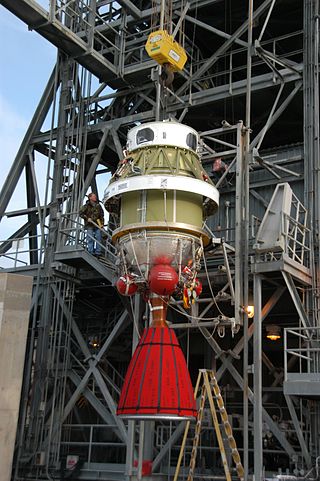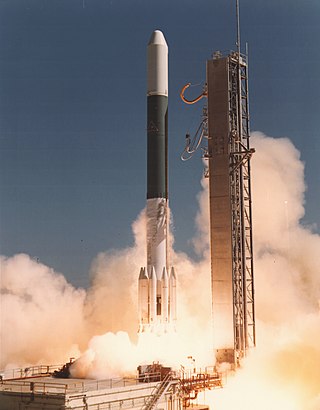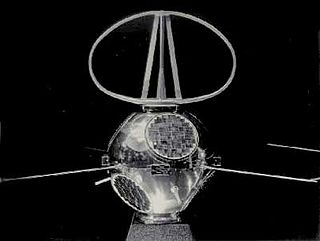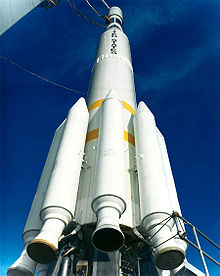
Delta II was an expendable launch system, originally designed and built by McDonnell Douglas, and sometimes known as the Thorad Delta 1. Delta II was part of the Delta rocket family and entered service in 1989. Delta II vehicles included the Delta 6000, and the two later Delta 7000 variants. The rocket flew its final mission ICESat-2 on 15 September 2018, earning the launch vehicle a streak of 100 successful missions in a row, with the last failure being GPS IIR-1 in 1997.

Delta is an American versatile family of expendable launch systems that has provided space launch capability in the United States since 1960. Japan also launched license-built derivatives from 1975 to 1992. More than 300 Delta rockets have been launched with a 95% success rate. Only the Delta IV Heavy rocket remains in use as of November 2020. Delta rockets have stopped being manufactured in favor of Vulcan.

The Thor-Able was an American expendable launch system and sounding rocket used for a series of re-entry vehicle tests and satellite launches between 1958 and 1960. It was a two-stage rocket, consisting of a Thor IRBM as a first stage and a Vanguard-derived Able second stage. On some flights, an Altair solid rocket motor was added as a third stage. It was a member of the Thor family and an early predecessor of the Delta.

The Scout family of rockets were American launch vehicles designed to place small satellites into orbit around the Earth. The Scout multistage rocket was the first orbital launch vehicle to be entirely composed of solid fuel stages. It was also the only vehicle of that type until the successful launch of the Japanese Lambda 4S in 1970.

Minotaur-C, formerly known as Taurus or Taurus XL, is a four stage solid fueled launch vehicle built in the United States by Orbital Sciences and launched from SLC-576E at California's Vandenberg Air Force Base. It is based on the air-launched Pegasus rocket from the same manufacturer, utilizing a "zeroth stage" in place of an airplane. The Minotaur-C is able to carry a maximum payload of around 1458 kg into a low Earth orbit (LEO).
Spin stabilization is the method of stabilizing a satellite or launch vehicle by means of spin, i.e. rotation along the longitudinal axis. The concept originates from ballistics, where the spin is commonly obtained by means of rifling. For most satellite applications this approach has been superseded by three-axis stabilization.

The Castor family of solid-fuel rocket stages and boosters built by Thiokol and used on a variety of launch vehicles. They were initially developed as the second-stage motor of the Scout rocket. The design was based on the MGM-29 Sergeant, a surface-to-surface missile developed for the United States Army at the Jet Propulsion Laboratory.

This comparison of orbital launch systems lists the attributes of all individual rocket configurations designed to reach orbit. A first list contains rockets that are operational or in development as of 2022; a second list includes all retired rockets. For the simple list of all conventional launcher families, see: Comparison of orbital launchers families. For the list of predominantly solid-fueled orbital launch systems, see: Comparison of solid-fueled orbital launch systems.

The AJ10 is a hypergolic rocket engine manufactured by Aerojet Rocketdyne. It has been used to propel the upper stages of several launch vehicles, including the Delta II and Titan III. Variants were and are used as the service propulsion engine for the Apollo command and service module, in the Space Shuttle Orbital Maneuvering System, and on the European Service Module – part of NASA's Orion spacecraft.
The N-II or N-2 was a derivative of the American Delta rocket, produced under licence in Japan. It replaced the N-I-rocket in Japanese use. It used a Thor-ELT first stage, a Delta-F second stage, nine Castor SRMs, and on most flights either a Star-37E or Burner-2 upper stage, identical to the US Delta 0100 series configurations. Eight were launched between 1981 and 1987, before it was replaced by the H-I, which featured Japanese-produced upper stages. All eight launches were successful.

The Delta N or Thor-Delta N was an American expendable launch system used for nine orbital launches between 1968 and 1972. It was a member of the Delta family of rockets, and the last Delta to be given an alphabetical designation - subsequent rockets were designated using a four digit numerical code.

The Delta 1000 series was an American expendable launch system which was used to conduct eight orbital launches between 1972 and 1975. It was a member of the Delta family of rockets. Several variants existed, differentiated by a four digit numerical code. Delta 1000 was developed by McDonnell Douglas company in 1972.

The Delta 2000 series was an American expendable launch system which was used to conduct forty-four orbital launches between 1974 and 1981. It was a member of the Delta family of rockets, sometimes called Thorad Delta. Several variants existed, which were differentiated by a four digit numerical code. The Delta 1000, 2000 and 3000 series used surplus NASA Apollo program rockets engines for its first and second stages.

The Delta 3000 series was an American expendable launch system which was used to conduct 38 orbital launches between 1975 and 1989. It was a member of the Delta family of rockets. Several variants existed, which were differentiated by a four digit numerical code.

The Delta 5000 series was an American expendable launch system which was used to conduct an orbital launch in 1989. It was a member of the Delta family of rockets. Although several variants were put forward, only the Delta 5920 was launched. The designation used a four digit numerical code to store information on the configuration of the rocket. It was built from a combination of spare parts left over from earlier Delta rockets, which were being retired, and parts from the Delta II 6000-series, which was just entering service.
Orion 3 was an American spacecraft which was intended for use by Orion Network Systems, as a geostationary communications satellite. It was to have been positioned in geostationary orbit at a longitude of 139° East, from where it was to have provided communications services to Asia and Oceania. Due to a malfunction during launch, it was instead delivered to a useless low Earth orbit.

Transit 3B was an American satellite which was launched in 1961 and operated by the United States Navy. It was a replacement for Transit 3A, which was lost in a launch failure the previous year. It carried instruments to demonstrate navigation and timing systems, and study geodesy to support the development of the Transit satellite navigation system.

LOFTI-1 was an American satellite which was launched in 1961 and operated by the United States Navy and Naval Research Laboratory. It was used to conduct research into the propagation of very low frequency radio signals in the ionosphere, and to investigate if these signals could be received by submarines. A 136.17 MHz transmitter was used for this investigation.

A small-lift launch vehicle is a rocket orbital launch vehicle that is capable of lifting 2,000 kg (4,400 lb) or less or under 5,000 kilograms (11,000 lb) of payload into low Earth orbit (LEO). The next larger category consists of medium-lift launch vehicles.
















